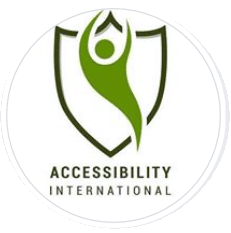Nonprofits face the combined crisis of COVID and economic peril. Support organizations offer to help us navigate these times. But almost without exception, the meetings are not accessible to staff with disabilities. This guide, part 3 of a 4 part series, will help you plan for meetings that welcome people of all abilities.
Before the pandemic, I would have guessed “Zoom fatigue” described too many close up shots in movies – what about you? Now we know it as a shared reluctance to join yet another bank of animated headshots that pass for meetings in COVID times. Researchers have given us many reasons why Zoom fatigue is real. Numerous studies have detailed that endless remote meetings are taxing to the spirit and brains of most people. When you add disability into the mix, the tech challenges and potential for discouragement and frustration increase. Planning for inclusion will help create online space that is less fatiguing and more productive for all.
Think broadly
Different people have widely different communication needs. Take those into account as you plan your meeting and associated outreach. Expect that people will be joining from screens of all sizes. They may have a low-bandwidth connection, use cameras and headphones of differing quality, and have varying levels of tech skills and experience with conference software. Communication about your meeting or webinar may include:
- Invitation and outreach
- Welcome to the meeting
- Meeting content
- Follow-up.
Let’s explore how inclusive thinking can improve each stage.
Invitation and outreach
People with disabilities will understand that they are welcome – or not – by the accessibility of the content you send. Are your emails accessible? Are you familiar with accessibility best practices for social media? If you can say yes to these questions, you’re on the right track.
Have you included features such as captions and accessible supporting materials? Let people know that in order to indicate that you have considered accessibility and welcome all attendees.
Is registration required? If so, make certain that registration forms are accessible to assistive technology that may be used by people with disabilities. It can be quite discouraging to have interest in a community meeting or webinar only to find that the registration system does not allow you to sign up.
Do you include contact information for tech support in outreach, confirmation, and reminder communications? This ensures that when attendees have trouble joining or using accessibility features, they know how to get help.
Create a welcoming space
A meeting may be a small interactive gathering or a broader informational webinar. You can make both feel personal and inviting. Choose meeting software with robust accessibility features and learn how those features work. Play music or sounds as people arrive or greet them individually if possible. Make your guests comfortable by clearly describing what to expect and how to interact and contribute. This changes based on the meeting purpose and size. Some suggestions for introductory comments:
- Be explicit about your commitment to inclusion and accessibility.
- Let attendees know how to ask for technical support if needed.
- Point to a code of conduct if you have one.
- Are there requirements for how to use the chat or the hand-raising function?
- Will there be polls or breakout rooms?
For large webinar type meetings, introductions may include the host name, presenter introductions, an agenda or general topic. For smaller meetings, you may suggest a round of personal introductions. Author and public speaker Haben Girma includes a physical description of herself and her surroundings for those who don’t see.
The Main Event
Nearly 1 in 4 adults in the US have disabilities. That number is likely to include some of your attendees. In addition to the accessible outreach and welcome outlined above, consider the following features and practices to ensure a more inclusive space.
Technical clarity and support
You may feel you are spending your life in virtual meetings, but that may not be true of your guests. Assign someone to monitor the technical aspects of the meeting. Tell attendees how to ask the monitor for help if they have trouble joining or using controls for video and audio. Monitors can watch the chat and pass along relevant questions or comments to presenters. They can intervene for those who have difficulties with tech in general or specific assistive technologies.
Captions
Inclusive meetings are captioned. Period. The choice is whether to have live or auto captions.
- Real time live captions are provided by captioning professionals and synced to the discussion. It is more accurate and is the preference of most deaf people. The cost is about $100 – $200 an hour. Live captions should be your first choice and be part of your budget if you know in advance that deaf people will attend.
- Auto-captions are generated by speech recognition software and are an option in several online conferencing apps. Enable them before the meeting starts and give attendees the choice to turn them on or not. Part of your meeting set up should always be to enable auto captions as a fall back.Then you can announce the option and are ready for deaf attendees who may have signed up at the last minute.
Captions benefit others as well. For example, parents may prefer captions while they keep an ear out for kids schooling at home. People whose first language is not English may use captions as a support. As with most accessibility features, while captions are essential for some users they can be useful for all depending on circumstances.
Accessible Materials
If you share digital materials and websites before, during, or after the meeting, verify that they meet document accessibility requirements for structure, contrast and scalability. Avoid PDFs unless they have been specifically remediated for accessibility. Auto checkers do not provide reliable validation of PDF accessibility.
Inclusive Presentations
For webinars or meetings with formal presentations, ask presenters to become familiar with accessible presentation techniques. Strive to foster interactivity and engagement as appropriate to the purpose and goals of the session. As you explore interactive possibilities, consider:
- Meeting minutes or recordings are useful for everyone.
- When sharing the screen or slides describe content for those who do not see it. Provide verbal description for animations, graphs, charts, cartoons, and video. Blind attendees, people joining from a small screen, and those on an audio-only connection benefit.
- Engage attendees to create a more interactive environment. For example:
- Allow participants to display handclaps or thumbs up options (don’t forget to describe icons for those who don’t see them);
- Encourage conversation in the (monitored) chat;
- Ask for interactivity when you construct a poll to use in your meeting.
- Use breakout rooms to facilitate small group interactions. Capture breakout room discussions through a brief “report back” session or through a pre-constructed online survey form. Be sure to assign captioners to breakout sessions as needed.
- Ask for a summary of lessons learned or takeaways from volunteers in the meeting.
Wrap up the main event by thanking your attendees. Tell them what to expect in the way of meeting minutes or takeaway activities. If slides or video will be posted – in an accessible format of course – let people know how and when to expect the link. Reiterate any contact information that you have provided.
Follow Up
It may be that your meeting requires follow-up or evaluation. Once again be mindful of the accessibility of your communication tools. Make sure your email communications are accessible. Verify sufficient contrast, meaningful link text, and descriptions of any important images in all emails. When asking participants to evaluate the session, use an accessible format to capture feedback. Including questions specific to accessibility features will encourage suggestions for how to improve.
Meetings for All
The benefits of diverse perspectives and inclusive environments have been studied and widely promoted. As organizations try to improve diversity, only 4% include disability in their inclusion efforts. Don’t be discouraged if you are among those who have not considered disability inclusion. In the accessibility community we often say that accessibility is a journey, not a destination. Together, we can create a digital world that is inclusive for people of all abilities. Thanks for reading and please stay in touch.



